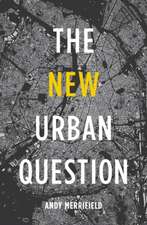Railway Development: Impacts on Urban Dynamics
Editat de Frank Bruinsma, Eric Pels, Hugo Priemus, Piet Rietveld, Bert van Weeen Limba Engleză Hardback – 19 oct 2007
| Toate formatele și edițiile | Preț | Express |
|---|---|---|
| Paperback (1) | 950.96 lei 6-8 săpt. | |
| Physica-Verlag HD – 6 noi 2014 | 950.96 lei 6-8 săpt. | |
| Hardback (1) | 956.03 lei 6-8 săpt. | |
| Physica-Verlag HD – 19 oct 2007 | 956.03 lei 6-8 săpt. |
Preț: 956.03 lei
Preț vechi: 1165.88 lei
-18% Nou
Puncte Express: 1434
Preț estimativ în valută:
182.93€ • 191.51$ • 151.37£
182.93€ • 191.51$ • 151.37£
Carte tipărită la comandă
Livrare economică 05-19 aprilie
Preluare comenzi: 021 569.72.76
Specificații
ISBN-13: 9783790819717
ISBN-10: 3790819719
Pagini: 300
Ilustrații: IX, 419 p.
Dimensiuni: 155 x 235 x 30 mm
Greutate: 0.75 kg
Ediția:2008
Editura: Physica-Verlag HD
Colecția Physica
Locul publicării:Heidelberg, Germany
ISBN-10: 3790819719
Pagini: 300
Ilustrații: IX, 419 p.
Dimensiuni: 155 x 235 x 30 mm
Greutate: 0.75 kg
Ediția:2008
Editura: Physica-Verlag HD
Colecția Physica
Locul publicării:Heidelberg, Germany
Public țintă
ResearchCuprins
The impact of railway development on urban dynamics.- The impact of railway development on urban dynamics.- Setting the scene.- Urban dynamics and transport infrastructure: Towards greater synergy.- Station areas as nodes and places in urban networks: An analytical tool and alternative development strategies.- HST stations and urban dynamics: Experiences from four European cities.- What makes a city: Urban quality in Euralille, Amsterdam South Axis and Rotterdam Central.- New Key Projects for station redevelopment in the Netherlands.- A multidisciplinary approach of railway station development: A case study of ’s-Hertogenbosch.- Evaluation studies.- Ex ante evaluation of railway station development projects: Issues still to be solved.- Multicriteria analysis of a high-speed railway station area development project.- Cost-benefit analysis of railway station area development: The case of Amsterdam South Axis.- Measuring the WTP for shopping facilities around railway stations.- High-speed rail and urban dynamics.- The impact of high-speed railway developments on office locations: A scenario study approach.- The effect of railway stations on office space rent levels: The implication of HSL South in station Amsterdam South Axis.- Regional high-speed trains on the Svealand line: Evaluation of effects.- Rail pricing and the supply of complementary commercial goods.- Light rail and urban dynamics.- Rail system development and urban transformations: Towards a spatial decision support system.- Rail-transit and real estate values in a polycentric city: A theoretic simulation approach.- Land use variables in trip generation models: The case of the light rail transit in Tel Aviv.
Recenzii
From the reviews:
"The book edited by Bruinsma and his colleagues address the issues of modern rail development (in this air and auto age) and put much on the table for analysts and policymakers … . strong value of this book–for both transport planners and policy scientists–is the collective wisdom from the perspectives shown in the case study chapters. … One strength of the book … will be looked at by policymakers as well as academics–is the depth and thought of the case studies." (Robert E. Paaswell, Journal of Regional Science, Vol. 49 (2), 2009)
"The book edited by Bruinsma and his colleagues address the issues of modern rail development (in this air and auto age) and put much on the table for analysts and policymakers … . strong value of this book–for both transport planners and policy scientists–is the collective wisdom from the perspectives shown in the case study chapters. … One strength of the book … will be looked at by policymakers as well as academics–is the depth and thought of the case studies." (Robert E. Paaswell, Journal of Regional Science, Vol. 49 (2), 2009)
Textul de pe ultima copertă
This book addresses the role of railways in urban development. The central aim is to inquire into how especially the development of high-speed rail and light rail links will affect European cities. The analyses are carried out with special attention given to the broader institutional environment of the railway system, including the shift toward privatised railway companies, internationalisation, the occurrence of market and government failures in land markets, and private-public partnerships in the development of railway station areas. The essence of the plans to invest in railway stations is that railway stations are not considered merely as nodes where people transfer from one vehicle to another, but also as places where spatial concentrations of high value activity are recognised as having a positive impact on cities. The development of real estate near stations is increasingly seen as a negotiation process in which both public and private actors play certain roles to revitalise central urban areas.
Caracteristici
Includes supplementary material: sn.pub/extras

















